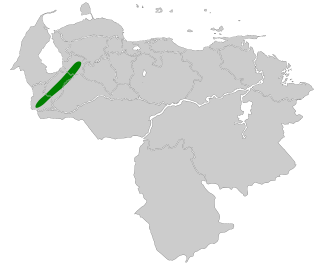
The rufous-breasted antthrush is a species of bird in the family Formicariidae. It is found in Colombia, Costa Rica, Ecuador, Panama, Peru, and Venezuela.

The stripe-headed antpitta is a species of bird in the family Grallariidae. It is found in Bolivia and Peru.

The yellow-breasted antpitta is a species of bird in the family Grallariidae. It is found in Colombia and Ecuador.

The grey-naped antpitta is a species of bird in the family Grallariidae. It is endemic to Venezuela.

The scaled antpitta is a species of bird in the family Grallariidae. It is found in Bolivia, Brazil, Colombia, Costa Rica, Ecuador, El Salvador, Guatemala, Guyana, Honduras, Mexico, Nicaragua, Panama, Peru, Trinidad and Tobago, and Venezuela.

The plain-backed antpitta is a species of bird in the family Grallariidae. It is found in Colombia, Ecuador, Peru, and Venezuela.

The white-bellied antpitta is a species of bird in the family Grallariidae. It is found in Colombia, Ecuador and Peru.

The chestnut-naped antpitta is a species of bird in the family Grallariidae. It is found in Colombia, Ecuador, and Peru.

The rusty-tinged antpitta is a species of bird in the family Grallariidae. It is endemic to Peru.

The chestnut-crowned antpitta is a species of bird in the family Grallariidae. It is found in Colombia, Ecuador, Peru, and Venezuela.

Watkins's antpitta is a Near Threatened species of bird in the family Grallariidae. It is found in Ecuador and Peru.

The hooded antpitta is a Near Threatened species of bird in the family Grallariidae. It is found in Colombia and Venezuela.

The ochre-breasted antpitta is a species of bird in the family Grallariidae. It is found in Bolivia, Colombia, Costa Rica, Ecuador, Panama, and Peru.

The scallop-breasted antpitta is a Near Threatened species of bird in the family Grallariidae. It is endemic to Venezuela.

The ocellated woodcreeper is a species of bird in the subfamily Dendrocolaptinae of the ovenbird family Furnariidae. It is found in Bolivia, Brazil, Colombia, Ecuador, Peru, and Venezuela.

The Imeri warbling antbird or Imeri antwarbler, is a species of bird in subfamily Thamnophilinae of family Thamnophilidae, the "typical antbirds". It is found in Brazil, Colombia, and Venezuela.

The streak-headed antbird is a species of bird in subfamily Thamnophilinae of family Thamnophilidae, the "typical antbirds". It is found in Bolivia, Colombia, Ecuador, and Peru.

The rufous-breasted antpitta, also called Leymebamba antpitta, is a species of bird in the family Grallariidae. It is found in Bolivia, Ecuador, and Peru.
The Muisca antpitta is a bird in the family Grallariidae. The species was first described by Frédéric de Lafresnaye in 1843. It was formerly called the rufous antpitta, which in 2020 was found to be a species complex composed of as many as 15 species, some of which were newly described. It is found in the Andes of northern Colombia and western Venezuela.

The rusty-winged antwren is a species of bird in subfamily Thamnophilinae of family Thamnophilidae, the "typical antbirds". It is found in Bolivia, Brazil, Colombia, Ecuador, Guyana, Panama, Peru, Suriname, and Venezuela.






















